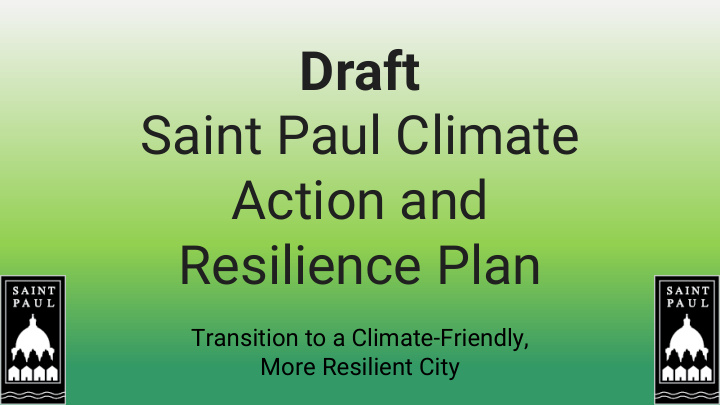



Draft Saint Paul Climate Action and Resilience Plan Transition to a Climate-Friendly, More Resilient City
Overview Why Create a Plan? ● Causes of Change ● Local Impacts ● Vulnerabilities ● Reducing Emissions ● Energy Use • Transportation • Waste and Water • What YOU can do • Questions • Source: https://www.spps.org/commed
We Use For Our Climate Science We use fossil fuels for our travel, ● ELECTRICITY heating, electricity and manufacturing OIL ● Extracting and burning fossil fuels HEATING releases greenhouse gases (GHGs) GHGs such as Carbon Dioxide (CO2) ● NATURAL GAS trap heat as it bounces off the Earth TRAVEL ● GHGs in our atmosphere has led to an increasing global average temperature COAL MANUFACTURING
Saint Paul is getting warmer What has happened: What we expect to happen:
Saint Paul is getting wetter The frequency and intensity of heavy rainfall are increasing What we expect to What has happen: happened:
Vulnerabilities PLACES PEOPLE Less tree canopy (hotter) Low income/wealth • • More air pollution (freeway People of Color/Native People • • corridors) Health challenges • More flooding Low access to transportation • • Low access to transportation Barriers in communication • • Infrastructure The very old/the very young • • Social Isolation •
Emissions from Energy and Travel Commercial/Industrial 42% Residential 20% Travel 31% Total 93%
0 (Zero) Net emissions by 2050! ▪ Electricity on good trajectory ▪ Transportation (harder) ▪ Building Heating (hardest)
50% Reduction by 2050 • 200 MW of new Solar within Saint Paul • 19,000 homes made deeply efficient • Much less travel in gasoline powered cars • Increase tree canopy from 32.5% to 40% • Xcel electricity 80% carbon free
Energy Priorities ● Energy Efficiency ● Reduce Energy Burden ● Renewable Energy and Energy Storage ● Electrification
Energy Burden
Transportation Goals Goals 2019-2025 2025-2030 Targets 2030-2040 Targets Targets Reduce Single Occupant Car Trips 10% 20% 40% Increase Transit 6% 25% 40% Ridership Increase Biking and 24 miles of new 85 miles of new 195 miles of new Walking bikeway bikeway bikeway Electric Vehicles 10% of all on- 33% 80% road vehicles
EV Community Mobility Hubs One public-facing Level 3 DC fast charger 70 total hubs Four Level 2 chargers Some with Level 3 chargers 2 battery electric vehicles (BEVs) Close proximity (<1/4 mile) to bus and rail
Solid Waste Reduction Goals • Increase waste diversion to 80% by 2030 • Reduce waste • Increase recycling and composting Source: Carleton University
Emissions Scenario
What YOU can do: Climate Resilience Prepare Emergency Disaster Prepare for power outages Preparedness Kit Create a buddy system to check on Stay informed on weather warnings neighbors and events - don’t get caught off Plant rain gardens and increase guard permeable surfaces on your property Cool down from extreme heat Make sure your drains are clear in case of downpour Seek natural cooling techniques Support your community food Make sure you have a reliable form markets of transportation
What YOU can do: Climate Mitigation This graph was developed by GreenFaith and is adapted from Wynes and Nicholas, 2017, Environmental Research Letter
Questions? Russ Stark, Chief Resilience Officer russ.stark@ci.stpaul.mn.us (651) 266-8511
Recommend
More recommend